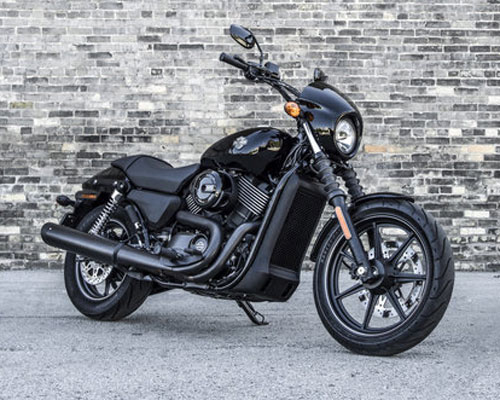
Harley-Davidson Street 750. One styling comment: The Japanese companies have years of experience in hiding a radiator on a liquid-cooled cruiser to make it look air-cooled. Harley could have picked up a few tips. (Harley-Davidson press photo)
Will people buy a Harley-Davidson made in India with a liquid-cooled engine? The answer would be a loud “no” (make that an angry “hell no!”) if by “people” I meant Harley’s traditional customer base. But with the new models Harley is rolling out for 2014, the people we’re talking about mostly live in places like Italy and India. They’re younger and more likely to be urban than the white, male, Baby Boomer Americans that have made Harley a success in recent decades.
As a result, the answer is not so simple to predict.
Consider the unusual situation Harley-Davidson is in.
Since the company was saved from bankruptcy (by hours) in the 1980s by a private buyout, Harley-Davidson has roared back from the grave. Lots of people want to credit Ronald Reagan (punitive tariffs on Japanese bikes) or Willie G. Davidson (styling “guru” and descendant of a founder), because that makes a better story, but demographics had a lot to do with it.
As it so often does, it has to do with Baby Boomers. Just as 1973 was the peak for motorcycle unit sales in the United States, the 1990s and the first decade of this century were an echo of that boom, as many of those who dabbled in motorcycling when young, then abandoned it to raise families or climb corporate ladders, returned to buy a new Harley as they hit middle age. How many easy-money home-equity loans turned into new Harley-Davidsons in the garage for Boomers whose homes were inflating (theoretically) in value at the same rate that their youth was fading in the rear-view mirror? We’ll never be able to quantify it.
But even in those flush, waiting-list years, Harley-Davidson executives knew they had a problem. Baby Boomers weren’t going to be around forever. And even before they shuffled off to a better place, they were going to stop buying new motorcycles.
It’s a hard thing, selling motorcycles as fast as you can make them, rolling in cash, but knowing that down the road the good times will end. It’s easy to change when you’re losing. It’s hard to change when you’re on top of the world.
But Harley tried. They introduced the V-Rod in 2001, with a more powerful liquid-cooled engine designed with input from Porsche, hoping it would attract younger buyers. They bought Buell Motorcycles to add sportier bikes to the lineup and stripped Eric Buell of his very name in a contract Buell’s own lawyer told him not to sign. They bought MV freakin’ Agusta. What could be further from the Harley-Davidson core than Eye-talian sportbikes?
When the financial crisis hit in 2008, none of it mattered, as motorcycle sales across the board cratered. Unable to tap their houses as piggy banks, people decided it no longer made sense to buy $35,000 ill-handling custom choppers that couldn’t be comfortably ridden any further than the nearest bike night gathering. Harley suffered, too. In 2009, Harley sales fell by nearly a quarter.
Those who want to suck up to the boss will point out that Harley’s stock price has nearly tripled since Keith Wandell was brought in from outside to be CEO in April, 2009. Others will point out that the S&P 500 has nearly tripled in that time, too, so he had the good fortune of being hired at the darkest economic hour. Either way, Wandell launched a back-to-our-roots campaign, axing Buell, selling MV Agusta, and launching the Dark Custom line to appeal to younger buyers. In other words, win them over with styling, which is cheap, instead of innovation, which costs real money.
Sales are way up. But Harley still hasn’t solved that old problem. Harley likes to brag that it is the top-selling brand among young people in the United States, but that’s just a form of whistling past the graveyard. I’m the world’s most attractive man among women who happen to be my wife, but that isn’t going to get me a Hollywood contract. Likewise, Harley can sell more bikes than Yamaha to the dwindling number of U.S. 20-somethings who have any interest in motorcycles and money to spend on them, but that’s not where the action is.
While Harley is kicking the Japanese companies’ collective asses in the United States, the Japanese and Italian and British and Indian and Korean and Chinese companies are selling bikes in the rest of the world. The new Street 750 and Street 500 are the latest efforts to get a piece of that action. The bikes for the U.S. market will be built domestically, but others will be built abroad.
The 50-something white male Boomers will scream, or perhaps steadfastly ignore the entire issue. They’ll say: It’s not air-cooled. It ain’t a real Harley. But it doesn’t matter. They are not Harley’s future.
So will people buy a Harley-Davidson made in India with a liquid-cooled engine? I have doubts, based mainly on price ($7,500 in the United States for the 750) and the dwindling image of iconic U.S. products abroad as superior, desirable, image-enhancing. But we will see.
In any case, Harley-Davidson has no choice but to try.
